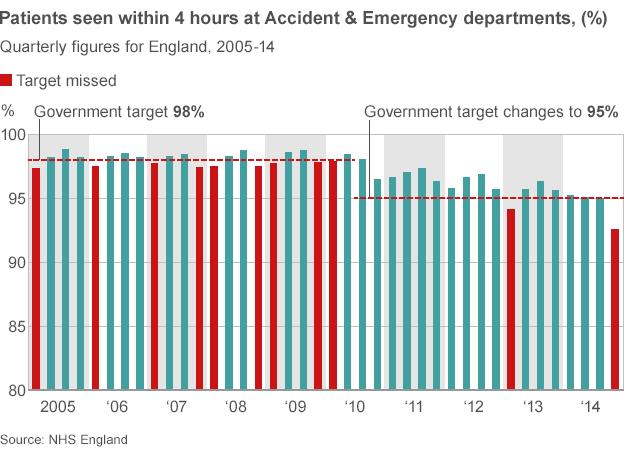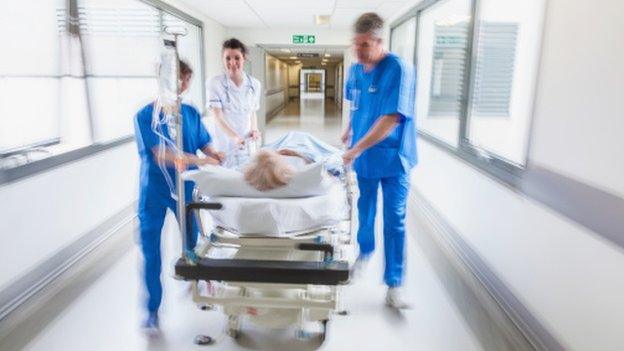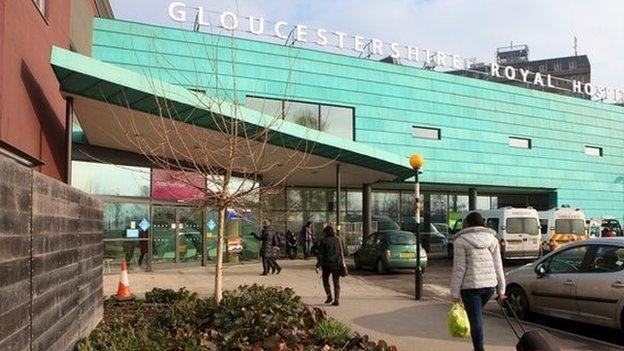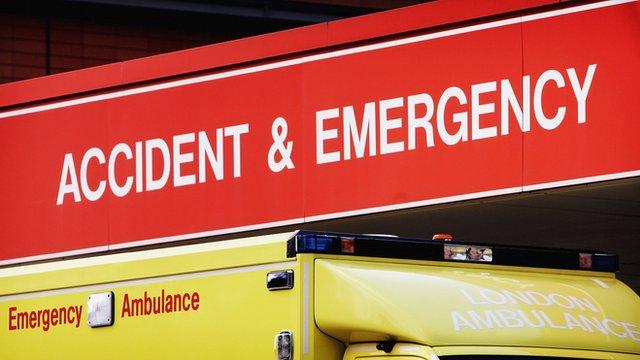A&E summit is needed to find a fix, Labour tells government
- Published
Ed Miliband called on David Cameron to apologise for breaking a "solemn promise"
Labour has called on the government to hold an urgent summit on how to alleviate pressure on A&E services in English hospitals.
Local government, emergency services and other NHS professionals need to agree co-ordinated action, it said.
The move comes a day after figures showed the NHS had missed its A&E waiting time target for the last three months of 2014.
The Conservative Party accused Labour of trying to generate headlines.
The pressure on hospital A&E departments has led to several declaring 'major incident' status this week.
The status triggers the implementation of extra measures, such as calling in off-rota staff and cancelling non-emergency care like routine operations.
Addenbrooke's Hospital in Cambridge is the latest big hospital to declare a major incident, citing "unprecedented levels of demand".
Hospitals in Staffordshire, Gloucestershire, Cambridgeshire, London and Surrey are also among those affected.

Hospitals currently most affected
The Royal Stoke University Hospital
Gloucestershire Royal Hospital
Cheltenham General Hospital
Ashford and St Peter's Hospitals
Walsall Manor Hospital
Peterborough City Hospital
Croydon University Hospital
Addenbrooke's Hospital

In a letter to Health Secretary Jeremy Hunt, shadow health secretary Andy Burnham said there had been a "failure" to anticipate the situation.
He suggested the problem was linked to a loss of social care capacity provided by councils this winter.
"You will know that I have repeatedly warned throughout this Parliament that severe cuts to social care could end up dragging down the NHS," he said.
"This is exactly what is happening now. Increasing numbers of very frail, elderly people are ending up in A&E and then becoming trapped in hospital because the care they need to be discharged is not available.
"This comes on top of pressures arising from the fact that people are finding it harder to see a GP, and pressures within the NHS from the shortage of nurses and GPs."
Patients describe their A&E experiences: "When we got to hospital, it was two hours waiting in the ambulance"
'Tough targets'
NHS England chief executive Simon Stevens said in response to the letter: "The NHS, the Department of Health, local clinicians and managers have - and are - doing everything possible to plan carefully, provide care safely, and put in place extra services to respond."
A Department of Health spokesman said: "The secretary of state has been holding weekly meetings about A&E pressures since March last year.
"Alongside colleagues across government and in NHS England, TDA (the NHS Trust Development Authority) and (NHS regulator) Monitor we continue to work with the local NHS to help support them through the winter."
Conservative MP Sarah Wollaston, chairwoman of the Commons Health Select Committee, said different hospitals faced different issues.
She told BBC Breakfast: "To say there is a one size fits all solution that can be plonked down by politicians would be completely wrong.
"It needs to be looked at in each individual health area by those clinical leaders in that area."
Mr Hunt earlier admitted that meeting the A&E standard was proving tough, but pointed out that England has some of the toughest targets in the world.
"Targets matter but not at any cost. The priority is to treat people with dignity and respect," he said.

The figures showed that from October to December 92.6% of patients were seen in four hours - below the 95% target.

Get involved on:
The performance is the worst quarterly result since the target was introduced at the end of 2004. The rest of the UK is also missing the target.
It is the second time the target - which measures the point from arrival to being discharged, admitted to hospital or transferred elsewhere - has been missed under the coalition.
In the first three months of 2013 94.1% of patients were seen in four hours.
"Dr Ali" tells Radio 5 live: "We can't tell people not to come to A&E because we're busy"
'Patient safety'
Mr Burnham referred in his letter to reports of "police and fire vehicles standing in for ambulances and ferrying people to hospital", which he said "raises major patient and public safety concerns."
He said a summit was needed to "assess the situation and put in place a coordinated plan to ensure patient safety and support the performance of A&E departments" to minimise any avoidable further major incidents being declared.
Meeting the A&E target has proved particularly tough since the end of the summer.
The target has been missed on a weekly basis - England provides these figures along with the quarterly statistics - every week except one since the end of August.
However, the performance in England is still better than elsewhere in the UK. The data in the other nations lags a bit behind England.
In Wales the data from November shows just 83.8% of patients were seen in time.
Northern Ireland is performing even worse - just over 80% of patients were seen within four hours in November.
Scotland has a slightly tougher waiting time target - 98% of patients should be seen in four hours - but in September 93.5% were.
Comparing the September figures for England and Scotland shows England was performing slightly better in that month.
It means according to latest data all parts of the UK are missing the A&E waiting time target.
- Published6 January 2015

- Published7 January 2015

- Published13 March 2015

- Published6 January 2015
- Published6 January 2015
- Published6 January 2015
